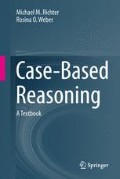Abstract
In this chapter examples support and complement the understanding of the previous chapters. In this chapter examples of major problem areas as classification, diagnosis, prediction, call centres, etc. are briefly introduced. We mainly discuss how example applications can be formulated in a form suitable for CBR. The examples show the variety of applications of CBR technology. The application types are illustrated by specific examples. These examples are supposed to indicate where CBR can be of use and what aspects in each application are suitable for the CBR methodology. They demonstrate the broad scope of CBR applications. The purpose of this chapter is to provide the reader with an initial impression of the reasoning tasks and application domains typical of CBR. We recommend it to readers who have completed reading the previous chapters. The descriptions are intended to provide examples for illustrating the concepts and methods mentioned mostly in Chap. 2, Basic CBR Elements. Throughout the chapter, we reference where to read further about new topics.
Access this chapter
Tax calculation will be finalised at checkout
Purchases are for personal use only
References
Aleven V, Ashley KD (1996) How different is different? Arguing about the significance of similarities and differences. In: Smith I, Faltings B (eds) EWCBR-96: advances in case-based reasoning. Third European workshop, Lausanne, Switzerland, November 1996. Lecture notes in computer science (lecture notes in artificial intelligence), vol 1168. Springer, Berlin, p 1
Althoff K-D, Faupel B, Kockskämper S et al. (1989) Knowledge acquisition in the domain of CNC machining centres: the MOLTKE approach. In: Boose J, Gaines B, Ganascia J-G (eds) EKAW 1989: third European workshop on knowledge acquisition for knowledge-based systems, Paris, July 1989, p 180
Ashley KD (1988) Modeling legal argument: reasoning with cases and hypotheticals. MIT Press, Cambridge
Bergmann R (2002) Experience management: foundations, development methodology, and internet-based applications. Springer, New York
Bloom BS (1956) Taxonomy of educational objectives: the classification of educational goals. David McKay, Ann Arbor
CBRWorks (2013) What is CBR-Works. http://cbr-works.net. Accessed 22 Feb 2013
Delany SJ (2006) Using case-based reasoning for spam filtering. Dissertation, Dublin Institute of Technology
Delany SJ, Bridge DG (2006) Textual case-based reasoning for spam filtering: a comparison of feature-based and feature-free approaches. Artif Intell Rev 26(1–2):75–87
Haigh KZ, Shewchuk JR, Veloso MM (1997) Exploiting domain geometry in analogical route planning. J Exp Theor Artif Intell 9:509–541
Igarashi T, Matsuoka S, Tanaka H (1999) Teddy: a sketching interface for 3D freeform design. In: 26th annual conference on computer graphics and interactive techniques. ACM SIGGRAPH’99, Los Angeles, CA. ACM, New York, p 409
Kamp G (1996) Using description logics for knowledge intensive case-based reasoning. In: Smith I, Faltings B (eds) EWCBR-96: advances in case-based reasoning. Third European workshop, Lausanne, Switzerland, November 1996. Lecture notes in computer science (lecture notes in artificial intelligence), vol 1168. Springer, Berlin, p 204
Kamp G (2003) Fallbasierte Unterstützung von Experten im Bereich Service and Support. Dissertation, Hamburg University
Li J, Ruhe G, Al-Emran A, Richter MM (2007) A flexible method for software effort estimation by analogy. Empir Softw Eng 12:65–106
Marling C, Whitehouse P (2001) Case-based reasoning in the care of Alzheimer disease patients. In: Aha DW, Watson ID (eds) ICCBR 2001: case-based reasoning research and development. 4th international conference on case-based reasoning, Vancouver, BC, Canada, July/August 2001. Lecture notes in computer science (lecture notes in artificial intelligence), vol 2080. Springer, Berlin, p 702
Taha D (2006) A case-based approach to computer aided architectural design. MONEO: an architectural assistant system. Dissertation, Alexandria University
Weber RO, Aha DW, Becerra-Fernandez I (2001) Intelligent lessons learned systems. Int J Expert Syst Res Appl. 20(1):17–34
Author information
Authors and Affiliations
Rights and permissions
Copyright information
© 2013 Springer-Verlag Berlin Heidelberg
About this chapter
Cite this chapter
Richter, M.M., Weber, R.O. (2013). Application Examples. In: Case-Based Reasoning. Springer, Berlin, Heidelberg. https://doi.org/10.1007/978-3-642-40167-1_4
Download citation
DOI: https://doi.org/10.1007/978-3-642-40167-1_4
Publisher Name: Springer, Berlin, Heidelberg
Print ISBN: 978-3-642-40166-4
Online ISBN: 978-3-642-40167-1
eBook Packages: Computer ScienceComputer Science (R0)

